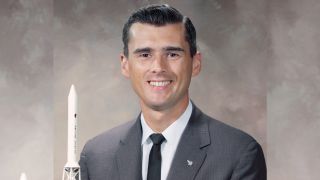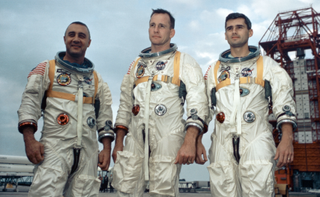Roger Chaffee: Engineer, aviator and Apollo 1 astronaut
The life of the skilled NASA astronaut Roger Chaffee was cut short in a tragic accident

Since childhood, Roger Chaffee dreamt of becoming an astronaut and, when he was selected to be in NASA's third group of astronauts, that goal became a reality, according to NASA's History Division. Unfortunately, this success was followed by tragedy, as Chaffee became one of the three fatalities in what was the U.S. space program's first major disaster.
Less than a month before Chaffee's first voyage to space, a flash fire killed him along with the rest of the Apollo 1 crew as the three astronauts underwent a preflight test on the launch pad. Chaffee didn't make it to space, but his achievements are celebrated by the space community with a great sense of heroism to this day and safety changes made following this tragedy have helped to pave the way for spaceflight history.
Related: Apollo 1: A fatal fire
Early life
Roger Bruce Chaffee was born in Michigan to parents Donald L. Chaffee and Blanche May Chaffee. According to the New Mexico Museum of Space History, he acquired a love of flying from his father, who had been a pilot during the 1930s – a role Roger Chaffee would later take on.
As a teenager, Chaffee excelled in science and mathematics and later developed an interest in electronics engineering, according to NASA. Following high school, he began a naval scholarship at the Illinois Institute of Technology in Chicago. However, after connecting his two passions of science and flying, Chaffee soon decided to transfer to Purdue University in Indiana to study aeronautical engineering, according to Encyclopedia Britannica.

In 1955, during his time at Purdue, Chaffee met Martha Horn, who he married two years later. Together, the couple had a daughter called Sheryl and a son called Stephen. In the few years after earning his aeronautical engineering degree, Chaffee completed his naval training and trained to become a pilot.
While Chaffee was pursuing his passion of flying, NASA was founded in 1958 and their first group of astronauts recruited the following year, according to NASA's History Division. Chaffee's next goal was to train as an astronaut test pilot.
NASA career
Chaffee continued to gain experience in the Navy and, in 1962, he was selected as one of 1,800 candidates to take part in astronaut candidate testing. A year later, this 1,800 had been narrowed down to 271 and, after passing many physical and psychological tests, Chaffee became one of NASA's 14 new recruits, according to the space agency.

In 1964, the Chaffee family relocated to Houston and Roger Chaffee began his astronaut training. Assigned to Project Gemini, his role was as "capsule communications specialist," according to NASA's History Division.
Gemini was launched the same year that President John F. Kennedy announced his goal to get astronauts to the Moon before 1970. It involved research into long-term space travel and served as preparation for the Apollo program. Chaffee’s role in Project Gemini involved operating the Deep Space Instrumentation Facility– a series of antennas used to communicate with missions in space. However, Chaffee eventually earned the title of "crew member" when he was selected to fly to space with the Apollo 1 mission, then called AS-204.
Apollo 1 fire
Joining the crew alongside fellow astronauts Gus Grissom and Edward White, Chaffee was set to put his extensive training into practice as the chief communications expert for the mission.
Chaffee took this role seriously, and while he and his colleagues were surrounded by flames during the preflight test, Chaffee continued to report the conditions over the radio, though the situation could not be controlled and none of the astronauts were able to escape.
Although Chaffee's career and life were cut short, he remains as one of NASA's most influential astronauts and his legacy transformed not just the Apollo program but human spaceflight overall.

Chaffee would have been the youngest man to fly to space had the Apollo 1 mission been successful, according to NASA. Although he was unable to fulfill this achievement, the fateful event did result in critical safety changes being made. These changes helped the first people to successfully and safely land on the Moon and return to Earth two years later in 1969. For example, the capsule hatch was altered so that the door could open outwards quickly for a fast and easier escape. During the catastrophic Apollo 1 pre-launch test, the cabin atmosphere was 100 percent oxygen. To reduce the chances of fires taking place again, this was changed to be a mixture of oxygen and nitrogen, according to the BBC.
Additionally, the spacesuit that Chaffee wore during the pre-launch test was made of flammable nylon netting. For the following Apollo missions, suits and other materials lining the space capsules were changed to non-flammable alternatives. Safety on the launch pad gained higher priority and apparatus and procedures were subject to intense focus testing.
The lessons learned continue to drive spaceflight today, and ensure that the deaths of Chaffee and his crew members help keep future crews safe.
You can follow Ailsa Harvey on Twitter at @ailsaharvey. Follow us on Twitter @Spacedotcom and on Facebook.
Join our Space Forums to keep talking space on the latest missions, night sky and more! And if you have a news tip, correction or comment, let us know at: community@space.com.
Get the Space.com Newsletter
Breaking space news, the latest updates on rocket launches, skywatching events and more!
Ailsa is a staff writer for How It Works magazine, where she writes science, technology, space, history and environment features. Based in the U.K., she graduated from the University of Stirling with a BA (Hons) journalism degree. Previously, Ailsa has written for Cardiff Times magazine, Psychology Now and numerous science bookazines.

